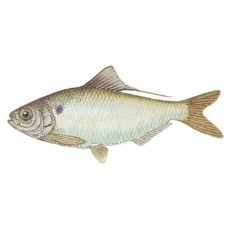Latin name
Dorosoma petenense
Other names
No information
Identification
The threadfin shad has a silvery color and a deeply compressed body, most easily recognized by the elongated, thin last ray of the dorsal fin. It has a small dark patch on the shoulder and its upper jaw does not protrude beyond the lower jaw. It is similar in appearance to other herring species, including the similarly sized but more northerly herring and the larger gizzard shad, with which it shares habitats and many of the same waters. It is distinguished from the similarly sized gizzard shad by its more pointed snout, terminal mouth, black spots on the chin and floor of the mouth, and yellow fins.
Distribution
Threadfin shad are found throughout the Mississippi River basin, from the Ohio River in Kentucky and southern Indiana southwest to Oklahoma and south to Texas and Florida, as well as other Gulf of Mexico and Atlantic drainages in Florida. They are also found in rivers in Guatemala and Honduras. They have been introduced as food species to Hawaii and the western United States, as well as other areas of the continental United States.
Habitat
Occasionally found in the brackish waters of estuaries and bays, the threadfin shad is primarily a freshwater fish found in large rivers, reservoirs, lakes, and backwaters where it lives primarily in open water.
Size
This species is usually found from 21⁄2 to 4 inches long and can reach a maximum length of 9 inches. Many filamentous fish do not live more than 2 years, although they can live 4 or more years.
Life history and Behavior
Threadfin shad spawn in the spring and fall near or over plants or other objects. They are prolific but short-lived and very susceptible to winter mortality from extremely low temperatures, which helps keep their numbers under control.
Food and feeding habits
Threadfin fish are filter feeders that feed primarily on plankton and organic detritus in open water. Sometimes they feed on fish larvae and organic material on sandy or muddy bottoms. In reservoirs and large lakes, these fish are constantly on the move, seeking out and feeding on the smallest plankton, whose location and level change seasonally and depending on various factors.
Reproduction
No information
| Classification | |
| Phylum | Chordata |
| Class | Actinopterygii |
| Squad | Clupeiformes |
| Family | Clupeidae |
| Genus | Dorosoma |
| Species | D. petenense |
| Features | |
| Conservation status | Least Concern |
| Habitat | Pelagic |
| Life span, years | 4 |
| Maximum body weight, kg | No information |
| Maximum length, cm | 2 |
| Sailing speed, m/s | No information |
| Threat to people | Edible |
| Way of eating | Planktonophage |

